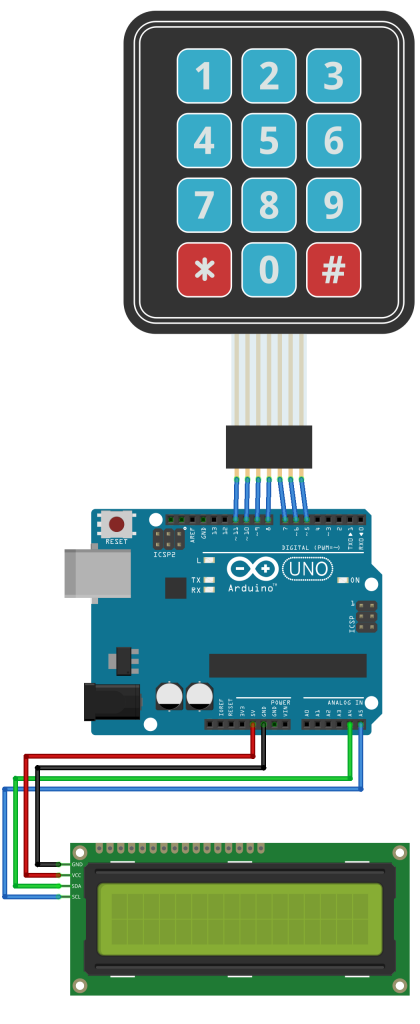Keypad (dalam konteks arduino) sama halnya dengan keypad pada handphone lawas (tuts) yang terdiri dari setidaknya 12 tombol berupa angka 0 hingga 9 serta karakter * dan karakter #. Untuk menuliskan karakter huruf, maka tuts keypad harus ditekan beberapa kali hingga karakter yang diinginkan muncul.
String / text terdiri atas karakter-karakter penyusunnya, penggunaan keypad 3×4 (numerik) membutuhkan trik khusus dan terdapat bermacam-macam metode, dalam contoh ini menggunakan metode entry deret.
aturan pemakaian umum:
- Masing-masing tuts memiliki beberapa karakter, untuk memilih karakter maka tuts yang sama ditekan berulang-ulang hingga karakter yang diinginkan tampil.
- Jika tuts/tombol tidak ditekan selama 3 detik, maka karakter sebelumnya dimasukkan dalam memory dan sistem lanjut ke karakter berikutnya.
- Jika tuts yang ditekan berbeda dengan tuts sebelumnya, maka karakter terakhir akan dimasukkan dalam memory.
- tuts * berfungsi untuk menghapus karakter terakhir
- jika tuts * pada saat belum ada karakter yang dimasukkan, maka sistem akan kembali ke sistem normal (dalam contoh ini kembali ke keadaan awal).
- tuts # berfungsi seperti ‘enter’ untuk menyimpan string dan kembali ke sistem normal (dalam contoh ini kembali ke keadaan awal).
skema pemanfaatan keypad sebagai entry teks:

koding/sketch masukan keypad sebagai string / teks :
1 2 3 4 5 6 7 8 9 10 11 12 13 14 15 16 17 18 19 20 21 22 23 24 25 26 27 28 29 30 31 32 33 34 35 36 37 38 39 40 41 42 43 44 45 46 47 48 49 50 51 52 53 54 55 56 57 58 59 60 61 62 63 64 65 66 67 68 69 70 71 72 73 74 75 76 77 78 79 80 81 82 83 84 85 86 87 88 89 90 91 92 93 94 95 96 97 98 99 100 101 102 103 104 105 106 107 108 109 110 111 112 113 114 115 116 117 118 119 120 121 122 123 124 125 126 127 128 129 130 131 132 133 134 135 136 137 138 139 140 141 142 143 144 145 146 147 148 149 150 151 152 153 154 155 156 157 158 159 160 161 162 163 164 165 166 167 168 169 170 171 172 173 174 175 176 177 178 179 | #define periodaKeypad 3000#include <LiquidCrystal_I2C.h>#include <Keypad.h>LiquidCrystal_I2C lcd(0x3F, 16, 2);const byte ROWS = 4;const byte COLS = 3;char keys[ROWS][COLS] = { {'1', '2', '3'}, {'4', '5', '6'}, {'7', '8', '9'}, {'*', '0', '#'}};byte rowPins[ROWS] = {11, 10, 9, 8};byte colPins[COLS] = {7, 6, 5};Keypad keypad = Keypad( makeKeymap(keys), rowPins, colPins, ROWS, COLS );char pad[11][11] = { "0 ", "1?!*#:=/+-", "2AaBbCc", "3DdEeFf", "4GgHhIi", "5JjKkLl", "6MmNnOo", "7PpQqRrSs", "8TtUuVvWw", "9XxYyZz",};byte padCounter;char padChar;bool padDitekan;byte charCounter;byte keySebelumnya;char bufferKeypad[17];char *bufferKeypadPtr;long millisKeypad;void setup() { Serial.begin(9600); Serial.println(F("Input string malalui keypad menggunakan arduino")); Serial.println(); Wire.begin(); Wire.beginTransmission(0x3F); if (Wire.endTransmission()) { lcd = LiquidCrystal_I2C(0x27, 16, 2); } lcd.begin(); resetInput();}void loop() { char key = keypad.getKey(); if (key) { switch (key) { case '0': case '1': case '2': case '3': case '4': case '5': case '6': case '7': case '8': case '9': millisKeypad = millis() + periodaKeypad; if ((key == keySebelumnya) || (keySebelumnya == 0)) { padChar = pad[key - '0'][charCounter]; keySebelumnya = key; } else if ((padDitekan) && (padCounter < sizeof(bufferKeypad) - 1)) { *bufferKeypadPtr++ = padChar; keySebelumnya = key; charCounter = 0; padCounter++; padChar = pad[key - '0'][charCounter]; } padDitekan = true; lcd.setCursor(padCounter, 1); lcd.print(padChar); lcd.setCursor(padCounter, 1); charCounter++; if (!pad[key - '0'][charCounter]) { charCounter = 0; } break; case '*': if (padCounter) { if (keySebelumnya) { keySebelumnya = 0; } lcd.setCursor(padCounter, 1); lcd.print(' '); charCounter = 0; padCounter--; bufferKeypadPtr--; padChar = *bufferKeypadPtr; lcd.setCursor(padCounter, 1); } else { resetInput(); } break; case '#': if ((padDitekan) && (padCounter < sizeof(bufferKeypad) - 1)) { *bufferKeypadPtr++ = padChar; } *bufferKeypadPtr = 0; Serial.print("String input = "); Serial.println(bufferKeypad); lcd.clear(); lcd.noBlink(); lcd.setCursor(0, 0); lcd.print("String input = "); lcd.setCursor(0, 1); lcd.print(bufferKeypad); delay(3000); resetInput(); break; } } if ((padDitekan) && (padCounter < sizeof(bufferKeypad) - 1)) { if (millisKeypad < millis()) { *bufferKeypadPtr++ = padChar; keySebelumnya = key; charCounter = 0; padCounter++; padDitekan = false; lcd.setCursor(padCounter, 1); lcd.print(' '); lcd.setCursor(padCounter, 1); } }}void resetInput(){ bufferKeypadPtr = bufferKeypad; charCounter = 0; padCounter = 0; keySebelumnya = 0; padDitekan = false; lcd.clear(); lcd.print("Masukkan string"); lcd.setCursor(padCounter, 1); lcd.blink();} |
library entry teks melalui keypad berbasis arduino :
LiquidCrystal-I2C.zip
Keypad.zip